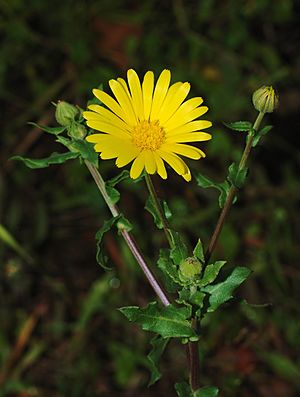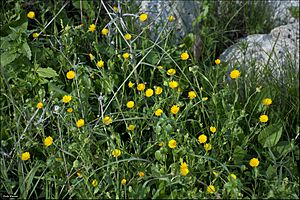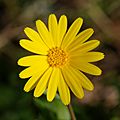Calendula facts for kids
Quick facts for kids Calendula |
|
|---|---|
 |
|
| field marigold (Calendula arvensis) | |
| Scientific classification |
|
| Kingdom: | Plantae |
| Clade: | Tracheophytes |
| Clade: | Angiosperms |
| Clade: | Eudicots |
| Clade: | Asterids |
| Order: | Asterales |
| Family: | Asteraceae |
| Subfamily: | Asteroideae |
| Supertribe: | Asterodae |
| Tribe: | Calenduleae |
| Genus: | Calendula L. |
| Species | |
|
See text |
|
Calendula is a group of about 15 to 20 types of plants, often called marigolds. These plants can be annuals (meaning they live for one year) or perennials (meaning they live for more than two years). They are herbaceous, which means they have soft stems instead of woody ones. Calendula plants belong to the daisy family called Asteraceae.
These plants originally grew in southwestern Asia, western Europe, Macaronesia, and around the Mediterranean Sea. Other plants are also known as marigolds, like corn marigold or plants from the genus Tagetes.
The name Calendula comes from a Latin word meaning "little calendar" or "little clock." This might be because the flowers often open and close with the sun. The common name "marigold" is thought to refer to the Virgin Mary. The most well-known Calendula plant is Calendula officinalis, also known as the pot marigold. Many herbal and beauty products named "Calendula" use parts from this specific plant.
Calendula is also one of the two birth flowers for the month of October.
Contents
What are Calendula Plants Used For?
How Calendula Was Used in the Past
Long ago, Calendula wasn't a main medicine, but people used it for simple problems like headaches, fevers, and toothaches. In the 1600s, some even thought it was good for the heart.
In ancient times, the golden Calendula flowers were used in many special events and traditions by Romans and Greeks. They sometimes wore crowns or garlands made from the flowers. One of its old nicknames is "Mary's Gold," because the flowers were used in early Christian events in some countries. In India, Calendula flowers are considered sacred and have been used to decorate statues of Hindu gods for a very long time.
However, the most common use for Calendula in the past was in cooking! People used the plant for its color and its taste. They added it to dumplings, wine, oatmeal, and puddings. In England, Calendula was often cooked with spinach or used to flavor birds. A writer from the 1500s, John Gerard, said that every proper soup in the Netherlands during his time would include Calendula petals.
Calendula in Cooking Today
The petals of Calendula are safe to eat. You can use them fresh in salads. They can also be dried and used to add color to cheese or as a less expensive replacement for saffron. They are great for making soups, stews, chicken dishes, custards, and drinks look more colorful.
In Britain, Calendula officinalis is often called 'pot-marigold' because it was commonly used in broths and soups.
Using Calendula for Dyes
You can get a dye from the Calendula flower. This dye can make beautiful shades of honey, gold, light browns, and bright yellows.
Medicinal Uses of Calendula
Calendula officinalis oil is still used in some medicines. It is known for helping with inflammation (swelling and redness) and healing wounds. You might find Calendula ointments (creams) for minor cuts, burns, and skin irritation.
Studies have shown that Calendula extracts might have properties that fight viruses and reduce inflammation. In herbalism, Calendula is used on the skin to help with acne, reduce swelling, stop bleeding, and calm irritated skin.
Some research suggests that Calendula cream or ointment can help people who are getting radiation treatment for cancer. It can help prevent skin problems and pain, which means fewer missed treatments.
Traditionally, Calendula has been used for stomach cramps and constipation. However, it's important to know that Calendula plants can cause allergic reactions in some people. Also, they should be avoided during pregnancy.
Types of Calendula Plants
There are many different types of Calendula species, including:
- Calendula arvensis – known as field marigold or wild marigold
- Calendula denticulata
- Calendula incana
- Calendula incana subsp. maderensis – Madeiran marigold
- Calendula incana subsp. maritima – sea marigold
- Calendula maritima - another name for sea marigold
- Calendula officinalis – the most common type, called pot marigold or garden marigold
- Calendula stellata
- Calendula suffruticosa
- Calendula tripterocarpa
Images for kids
See also
 In Spanish: Caléndulas para niños
In Spanish: Caléndulas para niños










